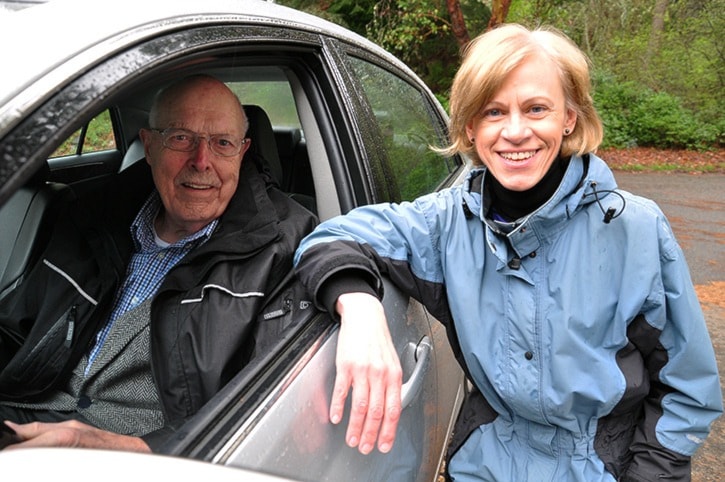Not much stops Tony Embelton from hitting the road in his roomy Toyota Avalon. The 91-year-old cruises to Cordova Bay to visit friends, to church or other social events around Greater Victoria, day or night.
In terms of an older driver, Embelton is a bit of an anomaly. With 70 years behind the wheel, the retired school principal prides himself on being a careful, steady motorist who isn’t intimidated by heavy traffic, aggressive drivers or bad weather – unlike many of his peers.
“I enjoy driving. I always have,” Embelton said. “Although I didn’t start driving until late, until I was in the army (in 1943). My parents didn’t have a car.”
Embelton is one of 125 senior-aged volunteers in Victoria, and 928 in Canada, participating in Candrive, a study that is taking a deep and detailed look at how to improve driving safety and quality of life for seniors.
Associated with the Centre on Aging and based out of the Candrive office at the University of Victoria, the Capital Region is among seven cities in the five-year program and a prime recruiting ground due to its large population of older residents.
Participants go through a battery of cognitive, reflex and perception tests, and volunteer information on their health and wellbeing. Their cars are rigged with a GPS and a memory card to record data on driving habits.
“Part of the questions they ask here is: do you drive at night? Or in the rain? I wonder why they ask that,” Embelton said at the Candrive office. “If you are careful on the road, what difference does it make?”
For many of the seniors in the study, being careful doesn’t cut it anymore. At least 40 per cent have restricted their own driving, with the majority opting to not drive in bad weather, at night or in heavy traffic. Many simply feel unsafe on the road, have failing eyesight or have experienced “near misses.” Some have been advised by family or their doctor not to drive.
“There is a perception in the community that older drivers aren’t changing and there should be more regulations. We are seeing that people are becoming more mindful and choosing to keep safe, and limit when and where they drive,” said Holly Tuokko, the director of the UVic Centre on Aging and lead on one of the sub-studies for Candrive.
Tuokko’s research is digging into the process behind why seniors self-restrict or abandon driving. Her work could help inform government policy around senior drivers, and help drivers decide when they should opt to stay off the road.
“People don’t just decide one day to stop driving. There is a process,” she said. “We’re looking to see if it’s the case that people are aware of changes, and then make their own choice to take themselves off the road if they don’t feel safe.”
Although male drivers between 16 and 25 by far cause the most mayhem on B.C. roads, ICBC stats show that older drivers may drive less, but per kilometre driven, they tend to crash at rates similar to young drivers. And for that older demographic, crashes are more likely to be fatal, or lead to broken bones and a long recovery.
“We want to keep people on the road for as long as possible, but safely,” Tuokko said. “The crash rate (for seniors) is not high, but when they occur it can be quite damaging.”
A broader goal of Candrive is to develop a tool for doctors to assess if their patient should keep driving, or if there is a high likelihood of a crash, based on mental acuity and physical condition.
This tool will be developed out of the many tests given to volunteers at the seven Candrive sites. “We hope to see which assessment tests correlate with safe and unsafe drivers,” said Phyllis McGee, the project co-ordinator for Candrive at UVic.
McGee’s office floor is covered in taped lines and markers on the walls to help with the three hours of physical tests and questionnaires for volunteers. Over 2009-10, 125 seniors between age 70 and 89 funneled through her office, and the vast majority have returned every four months.
“A handful of 89-year-olds signed up for a five year drive study," McGee said. "It’s a great example of optimism. And they’re still in the study and still driving.”
Participants in Victoria have tended to stop driving due to health problems – although a few were diagnosed with cancer, had treatment, went into remission and are still driving – while others had bad falls and broke bones. For the most part, participants in Victoria have cruised around without incident.
“We’ve had crashes but not as many as expected. It’s encouraging,” McGee said. “(Seniors) are less likely to do high-risk behaviour like speeding, although a few (of our participants) have got speeding tickets.”
Embelton said he learned to drive in the army, and that having a father as a police officer and a career as an educator made him a disciplined motorist. And driving, he observed, is more about fitness than age.
“It’s not about age at all, it’s about if you are well enough and strong enough … it’s about general health,” he said. “I’m lucky that I’m as well as I am for my age.”
Although not indicative of his driving record (one speeding ticket decades ago), Embelton admitted he hit a deer that leapt in front of him while driving in a line of traffic through Mount Doug Park. The timing could have been better.
“There was fur stuck to the car when you came to see me,” McGee deadpanned to Embelton. “Bit of evidence there."
For more on Candrive, click here.
editor@saanichnews.com
